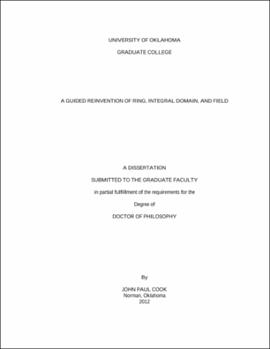| dc.description.abstract | Abstract algebra enjoys a prestigious position in mathematics and the undergraduate mathematics curriculum. A typical abstract algebra course aims to provide students with a glimpse into the elegance of mathematics by exposing them to structures that form its foundation--it arguably approximates the actual practice of mathematics better than any of the courses by which it is typically preceded. Regrettably, despite the importance and weight carried by the abstract algebra, the educational literature is replete with suggestions that undergraduate students do not appear to be grasping even the most fundamental ideas of the subject. Additionally, many students fail to make the connection between abstract algebra and the algebra they learned at the primary and secondary levels, perpetually blind to any interpretations of the subject beyond surface-level. These discrepancies have two problematic consequences. First, students who were otherwise enthusiastic and interested in mathematics experience a complete reversal and become indifferent and disengaged. Second, future mathematics teachers at the primary and secondary levels do not build upon their elementary understandings of algebra, leaving them unable to communicate traces of any deep and unifying ideas that govern the subject. To address this problem, it has been suggested that the traditional lecture method be eschewed in favor of a student-centered, discovery-based approach. There have been several responses to this call; most notable and relevant to this project is the work of Larsen (2004, 2009), who developed an instructional theory to support students' reinvention of group and group isomorphism. As no such innovative methods of instruction exist regarding ring field theory, this project details the development of an instructional theory supporting students' reinvention of fundamental structures from ring theory: ring, integral domain, and field. Rooted in the theory of Realistic Mathematics Education, this dissertation reports on a developmental research project conducted via multiple iterations of the constructivist teaching experiment, wherein the primary goal was to test and revise an instructional theory supporting the guided reinvention of ring, integral domain, and field. The findings include an empirically tested and revised instructional theory, as well as conceptual frameworks detailing the emergence and progressive formalization of the key features in a ring structure. | |
